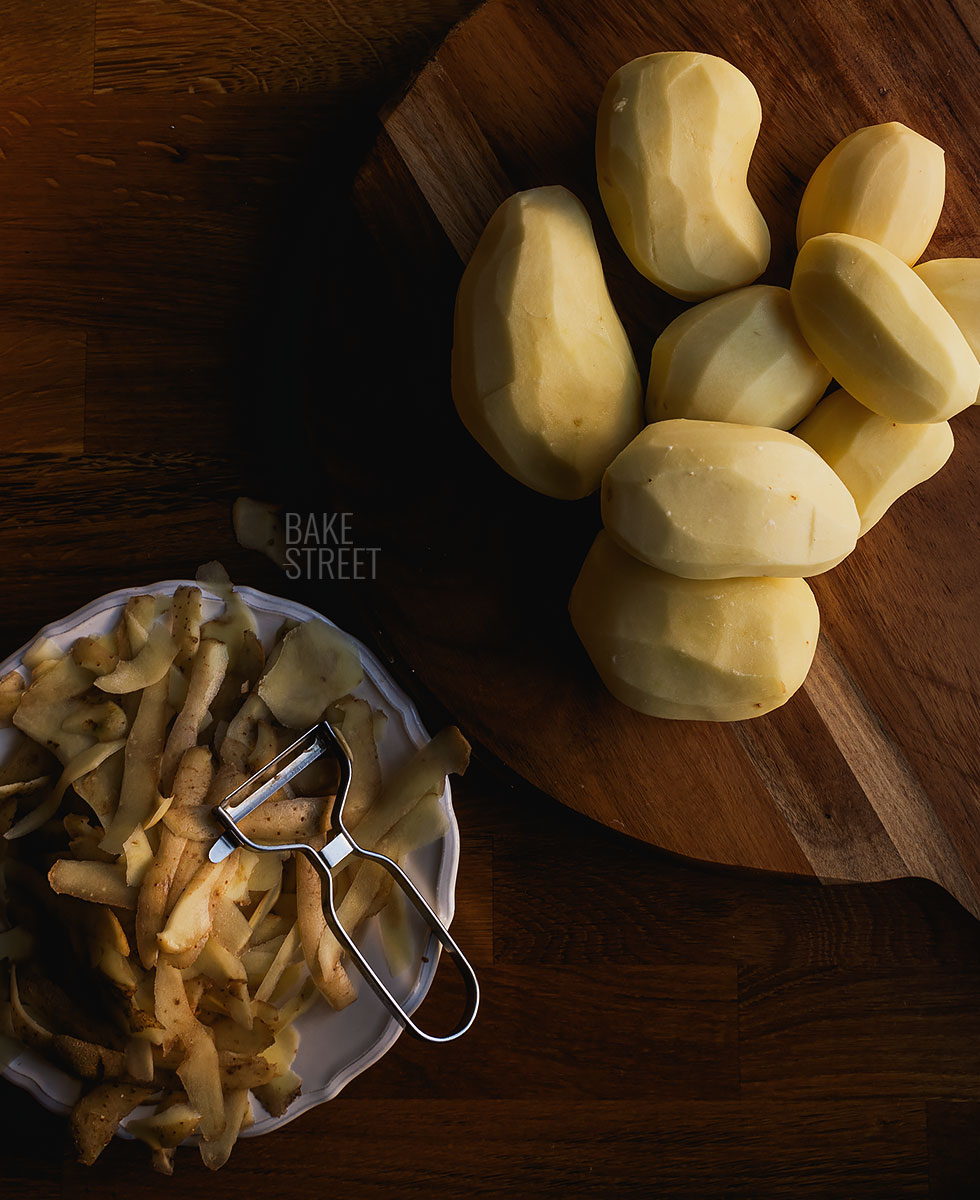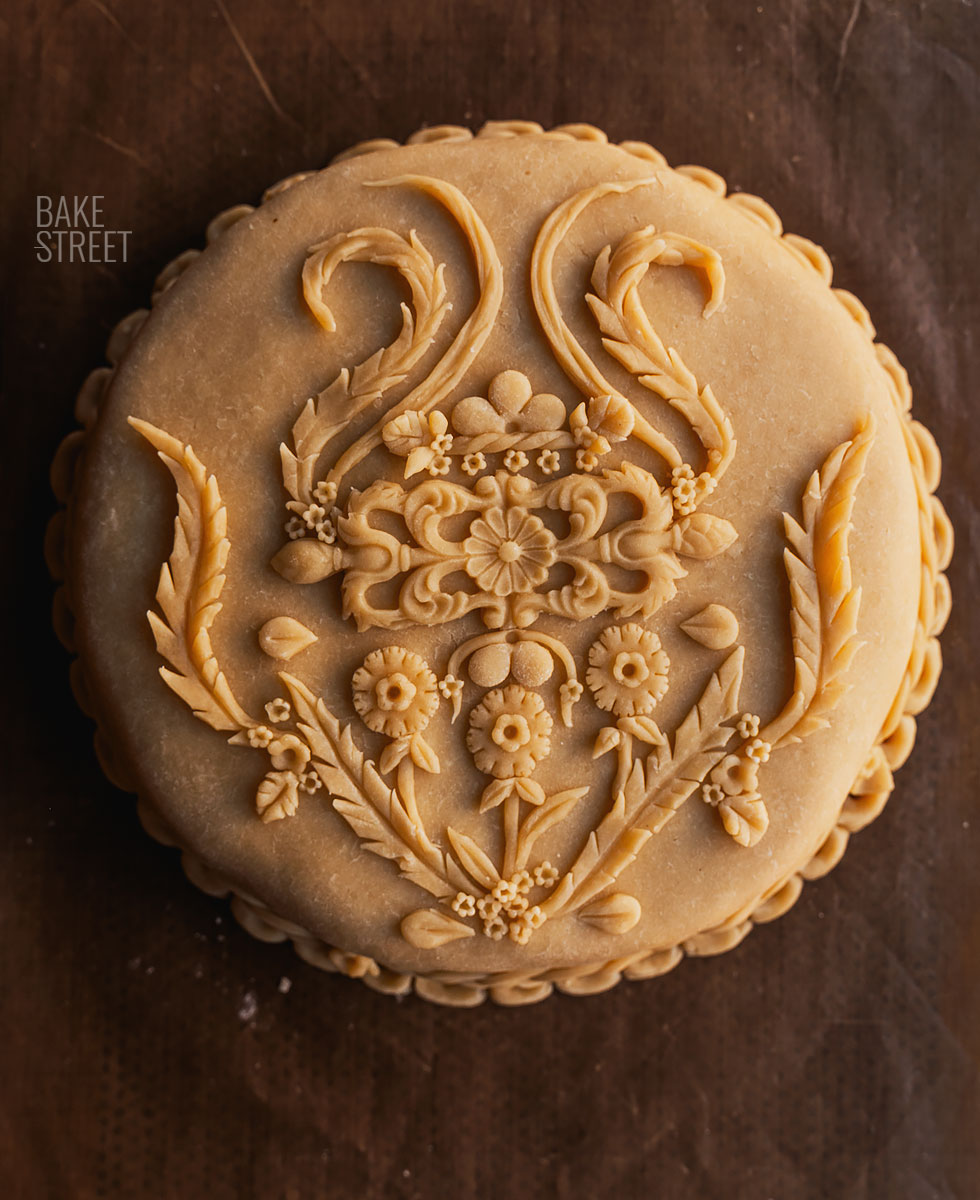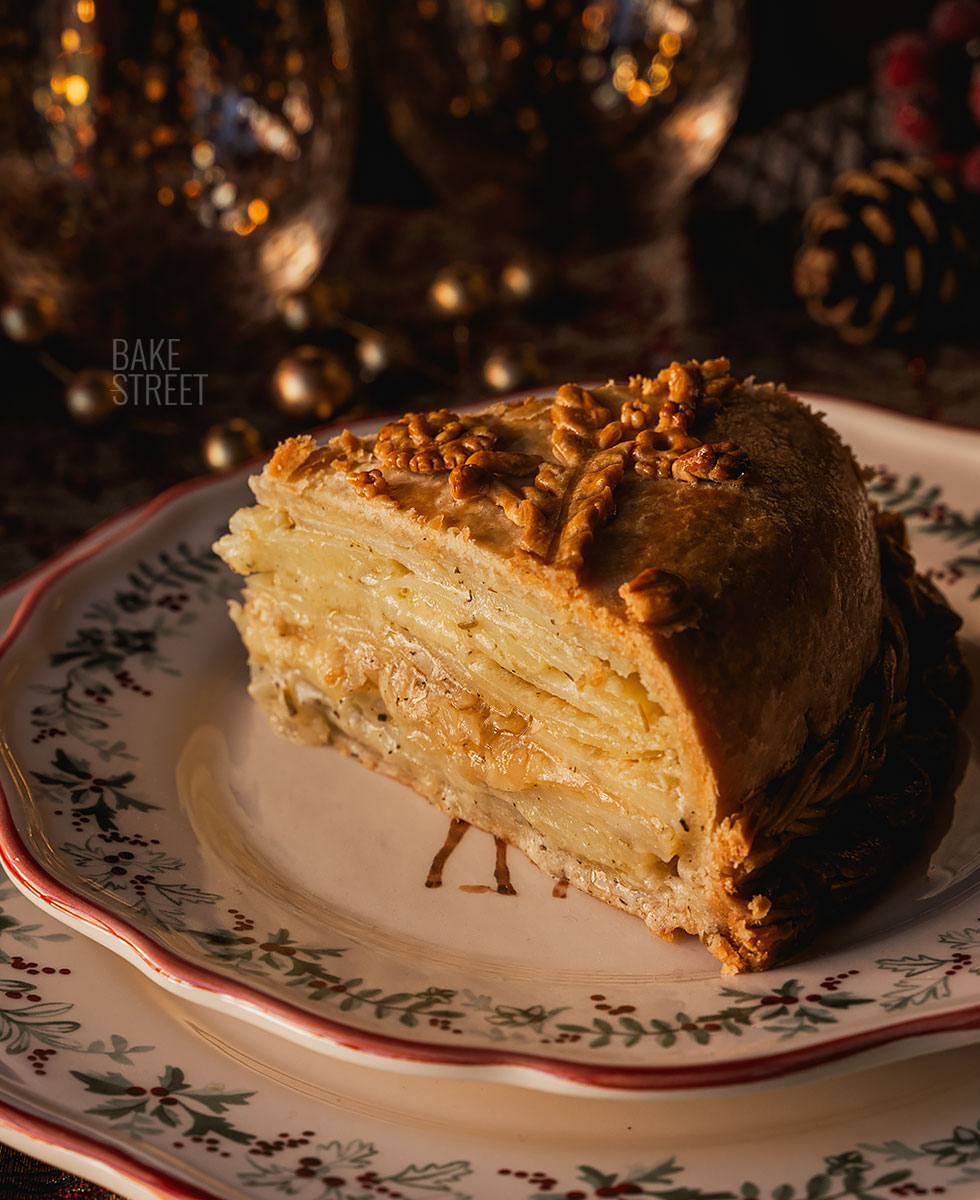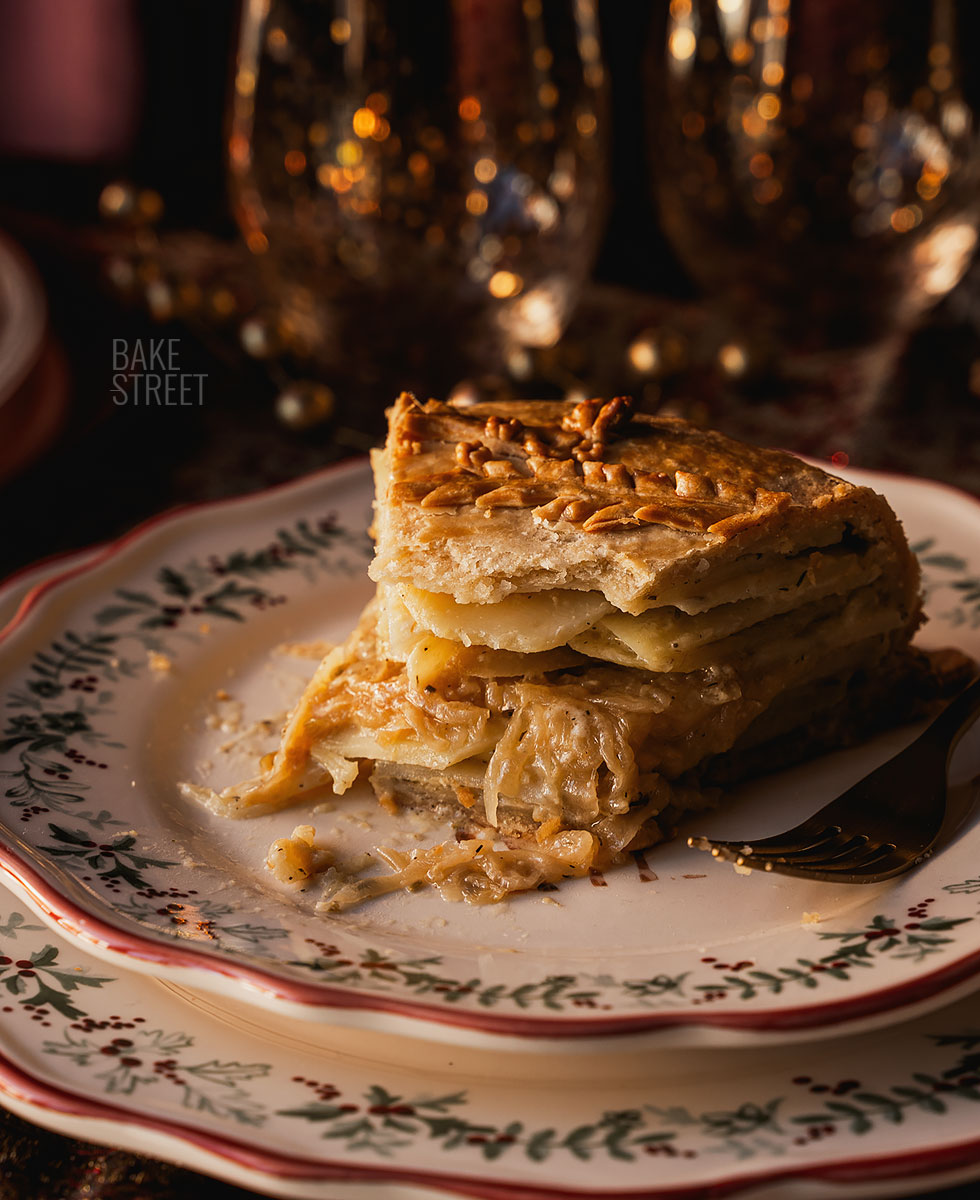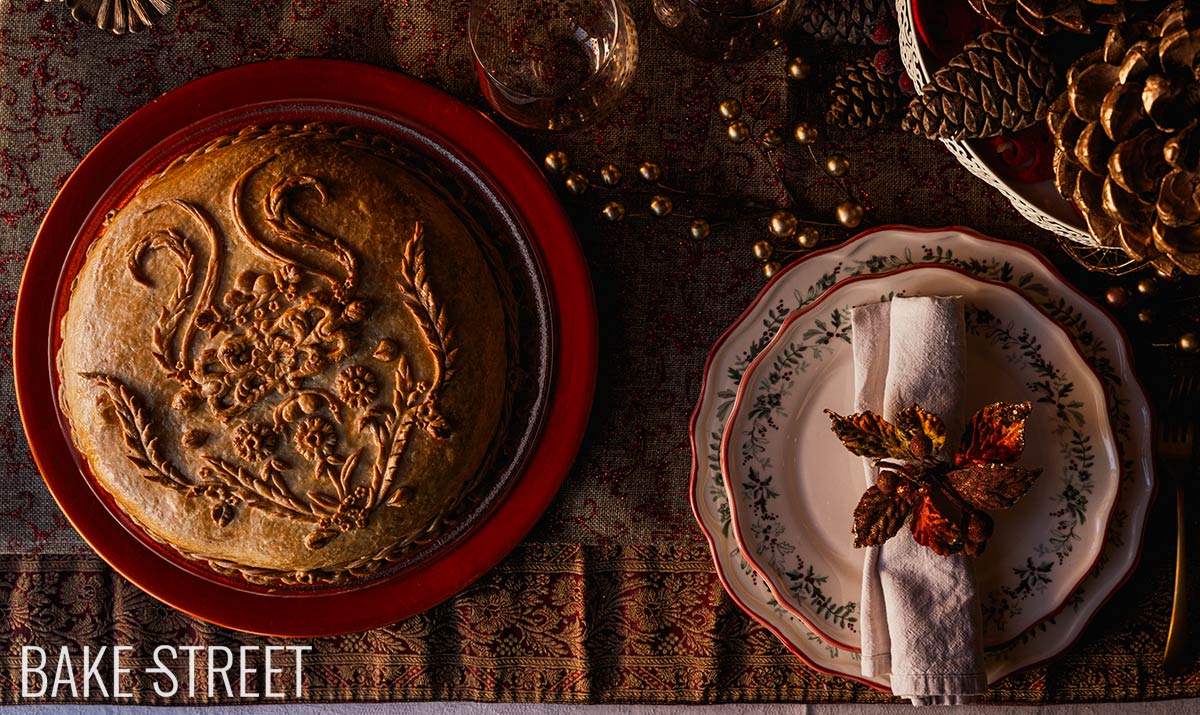
Dauphinoise potato and caramelized onion pie
I have been thinking for a few weeks about some pâté en croûte recipes that I want to make, but I still haven’t found the recipe I want to use. Not because I don’t like them, but because I’m having a hard time deciding. In addition, almost two years ago I was given a beautiful mold that I can’t wait to use and that, for one reason or another, I don’t make. So to get rid of the itch, I thought I’d leave you with this Dauphinoise potato and caramelized onion pie.
I really wanted to make again a savory pie with crust and beautiful decorations. In fact some time ago I left you two great versions: this curried potato and spinach pie and this black pudding, pear and pine nuts pie. Well, I also left you a vegetable and meat pâté en croûte, but there is still a lot of room for improvement.)
This savory pie is a recipe from chef Calum and his book “The Pie Room“, which I highly recommend. Especially if you like this kind of elaborations. He makes real edible beauties.
In my case I have varied some minimal detail, but I have followed his process and ingredients mostly. From here I thank you for sending us such a splendid and inspiring work 🙂
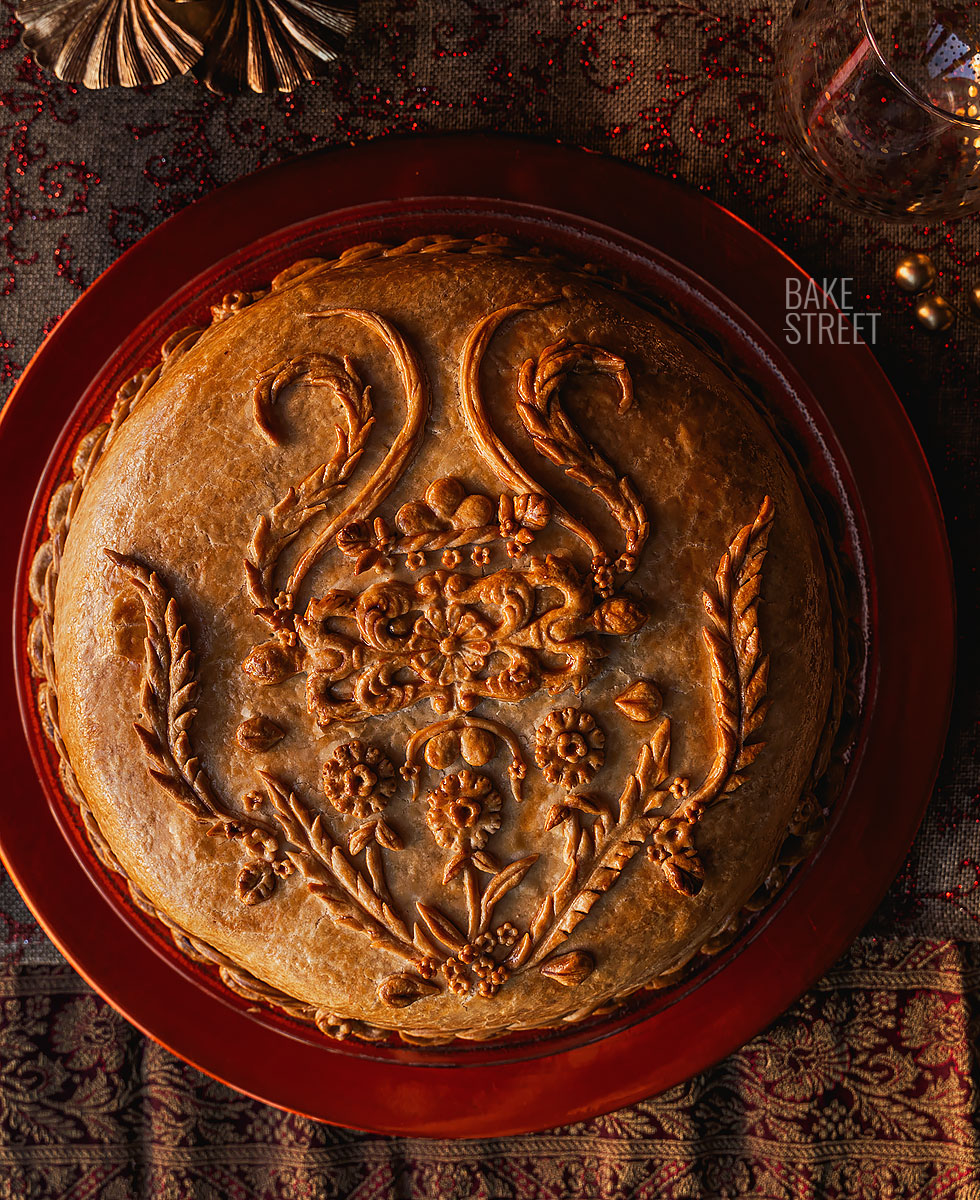
Potato Dauphinoise origin.
This pie is made with the famous French potato gratin, better known as potato Dauphinoise, caramelized onion and cheddar cheese.
The origins of potato gratin, or gratin dauphinois, date back to the beginning of the 16th century, when this tuber was incorporated into the plantations. Today, the dish comes in a wide variety of versions that include ingredients such as minced meat, goat cheese, camembert or zucchini, among others.
The history of gratin dauphinois dates back to the year 1500 in the Dauphiné region, located in southeastern France and created in the 11th century under the influence of the Counts of Albon. In 1349, the Dauphiné was incorporated into French territory when Charles V became the first Dauphin of France, destined to become the future King. This region retained a certain autonomy until 1457, when it became part of the domain of the son of the King of France.
The nickname “Dauphin” comes from the fact that most of the heirs of the county of Viennois bore the middle name “Dauphin“. This male name, uncommon compared to “Délphine“, which is more common in women, became by extension the title given to all firstborns and heirs presumptive to the crown of France.
Today, Dauphiné is divided into four departments: Isère, Drôme, part of the Rhône and the Hautes-Alpes.
The creation of the first gratin dauphinois is related to the spread of the potato in Europe. Its cultivation began in 1565 in Italy and in 1589 in Switzerland thanks to the adaptability of the tuber to alpine conditions which facilitated its cultivation.
On June 7, 1788, Grenoblewas the scene of a riot that marked the French revolutions, known as the “Day of the Tiles”. At that time, the Duke of Clermont-Tonnerrewithdrew his troops from the insurgents to avoid the risk of a massacre. The duke, then lieutenant general and commander-in-chief of Dauphiné, organized on July 12 a meal for the municipal officials of Gap. According to Dauphiné historian Claude Muller, this meal marked the official inscription of the word “gratin dauphinois“.
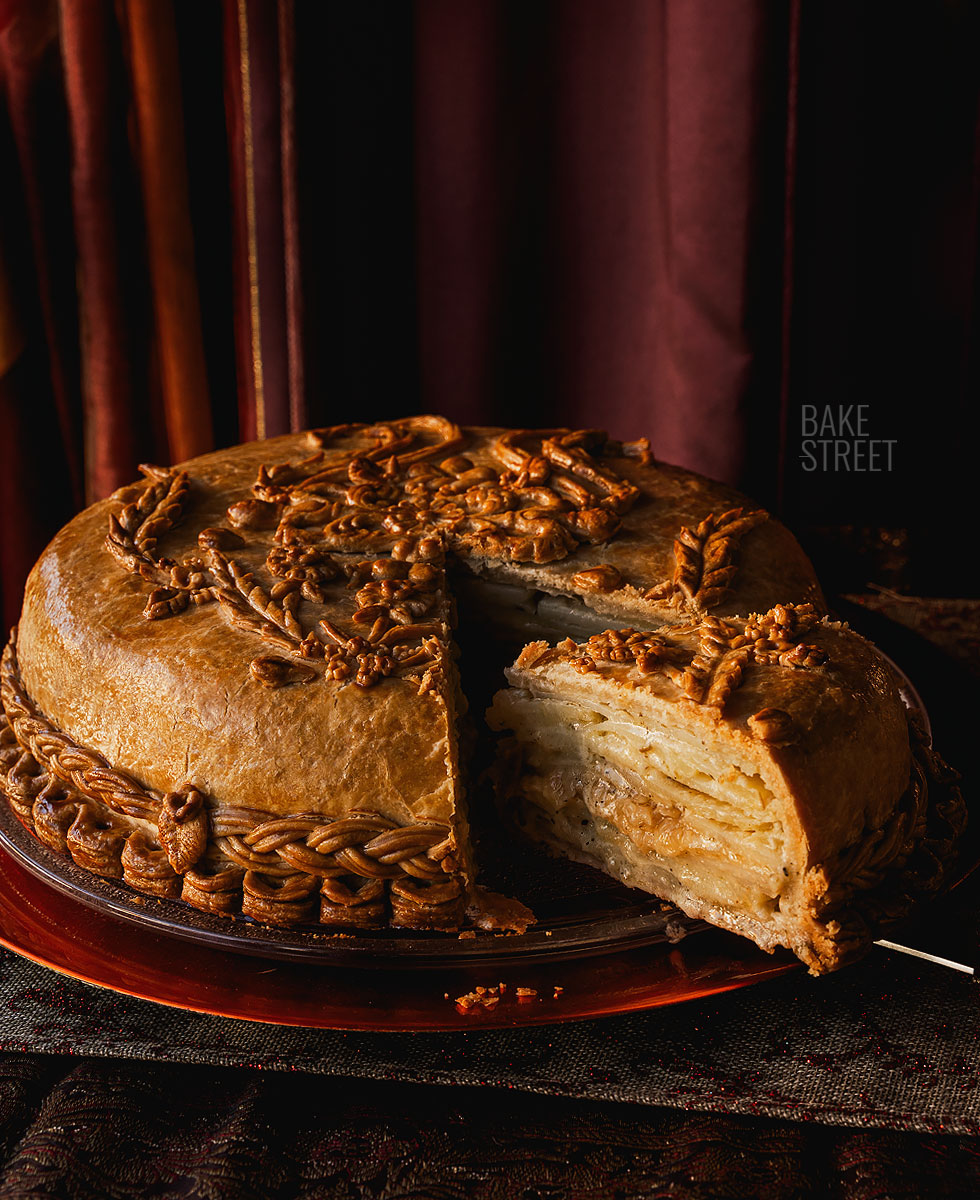
Shortcrust pastry.
Shortcrust pastry, one of the most recognized products of traditional pastry making, is a type of dough that can be prepared even without good pastry knowledge. It is an easy dough that only requires following the specified steps and temperatures to obtain a good result.
This dough is characterized by good elasticity, crumbliness, resistance to transformation and plasticity: qualities that stand out in a well-executed shortcrust pastry. Thanks to its versatility, it is the basis of many desserts, from classic jam tarts to cookies, from modern cakes to my beloved pâté en croûte.
Although there is no official record of its creation date or origin, it seems that shortcrust pastry was already known in the year 1000, when artisans began to make it, using the abundant sugar cane imported from Near Eastern countries.
The French cook Guillaume Tirel (1326-1395) alias Taillevent, renowned chef to several Kings of Medieval France, was the first to document the process, describing its preparation in his manuscript “Le Viandier“.
Le Viander is an important book and work of gastronomy. It studies European cuisine at a time when it was beginning to move away from Gallo-Roman traditions. Before Taillevent, chefs had no cookery guides or recipe books, so rare were the handwritten copies of the De re coquinaria, often mutilated and corrupted from the book by Marcus Gavius Apicius. A century after his death, book printing was responsible for spreading Taillevent’s work.
Cooking was intended to become a science, with its rules and laws. Taillevent’s book is rich in the description of condiments and abundant in explanations and processes, and also tells stories from the cantares de gesta and chivalric novels of the Middle Ages. Several of its chapters refer to the elaboration of wine and the medieval verjuice(acidic juice of white grapes or apples).
Together with the Ménagier de Paris (a book containing advice for a medieval French housewife on how to please her guests with recipes), it is the reference work for cooking in the Middle Ages.
Later, Bartolomeo Scappi continued the tradition, making shortcrust pastry, with its variants, one of the most popular and widely used sweet recipes.
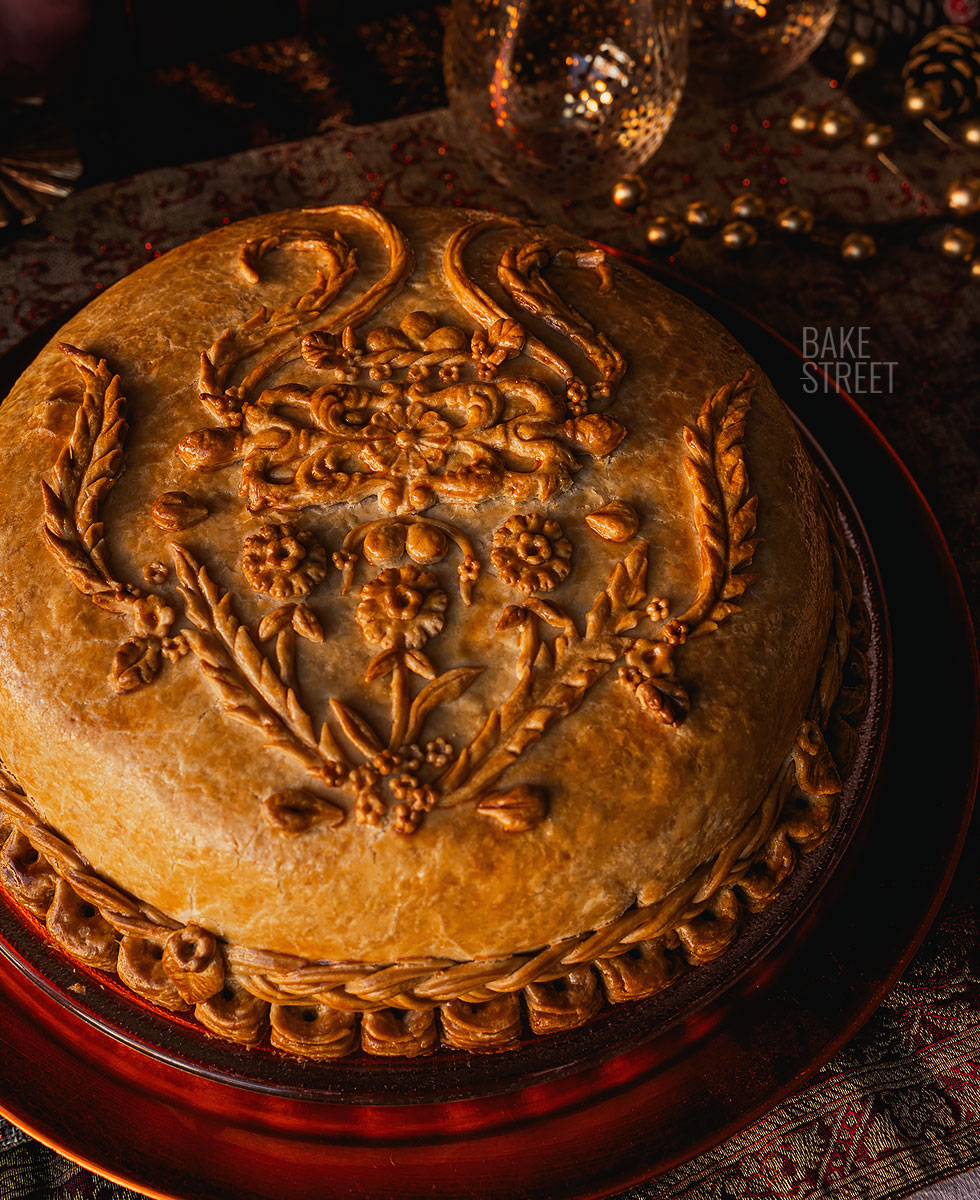
Making Dauphinoise potato pie with caramelized onion.
This pie requires several steps in its process, so it is important to organize in advance to be able to carry it out in a relaxed and calm way. In my case, I divided the process into three days, but this can be reduced to two, even one. Although my advice is to carry it out in two days at least, so as not to go under too much pressure.
First we will elaborate the potato stuffing. A first cooking process is required to cook the potatoes together with the sauce, onion and cheese. Once they are cooked, we must let them cool and refrigerate so that they acquire firmness. Chef Calum details in his book that the filling, once completely cooled, should be refrigerated for at least one hour. The reason is that we must unmold the filling and place it on top of the dough. In my case I chose to leave it in the refrigerator for about 14 hours, I made it in the afternoon and it was in the fridge overnight.
Then we will prepare the dough. It is very easy to prepare and only needs to spend an hour in the refrigerator before working with it.
The assembly and decoration part is the longest and most laborious, not because of its difficulty, but because it requires time to decorate it. The process itself is simple, we just need to keep the dough cold to work well with it.
In the book a simpler decoration is carried out, but equally very nice, some leaves carried out with a cutter. For my part I kept the braid on the bottom edge, which I found absolutely beautiful, but the top decoration was something that came up while I was making it.
I wanted to follow something similar to the previous savory pies I left you, but I didn’t know how I was going to do it. I was inspired by the work of my dear Julie Jones, especially in this cake, and I got carried away. A little before decorating it, I remembered the silicone mold I had and decided to use it for the first time (I hadn’t used it yet). The rest of the decorations were emerging in the process.
Once the pie is assembled and decorated, the book advises to refrigerate the assembled cake for at least 30 minutes. In my experience, whenever I prepare pies of this type, with such detailed decorations and where we want the shapes to remain perfect and intact, I always leave the pie overnight in the refrigerator.
This step has always worked very well for me and the dough keeps its shape in perfect condition. Without deforming even a millimeter.
Finally, brush the cake with yolk beaten with water, let it rest for 30 minutes in the refrigerator so that the yolk sets well and proceed to bake the cake.
I know it takes time and work, but the result is so spectacular that I give you my word that it is worth it a thousand times
Recipe Dauphinoise potato and caramelized onion pie
DAUPHINOISE POTATO STUFFING:
- 1.5 kg of peeled potato, I used the Monalisa variety
- 375 g crème fraîche
- 500 g semi-skimmed milk
- 3 cloves of garlic, large
- 3 g dried rosemary
- 3 g dried thyme
- 15 g salt
- 200 g Cheddar Mature cheese
CARAMELIZED ONION:
- 4 sweet onions, large
- 25 g olive oil
- 15 g unsalted butter
- pinch of salt
SHORTCRUST:
- 500 g flour T45 or bread flour or with 11-12% proteins
- 250 g unsalted butter, cold
- 60 g cold water, from the refrigerator
- 2 eggs L
- 10 g salt
FOR BRUSHING:
- 1 egg yolk + 1 Tbsp water
MATERIAL WE WILL NEED AND SHOWN IN THE VIDEO:
- KitchenAid stand mixer*
- crystal bowl KitchenAid*
- mandolin, this is mine from DeBuyer*
- adjustable rolling pin
- marble rolling pin* (optional) or another type of rolling pin
- round mold 23-25 cm diameter (mine is 23 cm)
- large frying pan, this is mine De Buyer*
- silpat or teflón sheets
- perforated tray, mine is DeBuyer*
- scraper*
- flower cutters with and without ejector (these are mine)
- sharped knife
- pastry brush
- cooling rack
*In these products you have a 5% discount on the website Claudia&Julia using this code BAKESTREET. Delivers throughout Europe.
Instructions
Prepare potato Dauphinoise.
- With the help of a peeler, preferably to avoid losing as little potato as possible, peel the potatoes.
- Wash under cold running water.
- With the help of a mandolin, slice the potatoes to a thickness of 2-3 mm. Set aside.
- Peel the onions, removing the outer part, and slice with the mandolin to the same thickness as the potatoes.
- Finally, peel the garlic cloves and slice.

Cook potatoes.
- In a large skillet or saucepan, add the crème fraîche along with the milk, salt and spices.
- Place over medium-low heat and cook until slightly heated through.
- Stir the potatoes into the milk mixture, raise the heat slightly and bring to a gentle simmer. Cook for 4 minutes, stirring constantly, to prevent the potatoes from sticking to the base.
- Remove the potatoes, drain well and set aside. Keep the leftover liquid or sauce in a bowl, we will use it later.
- NOTE: To speed up the process of assembling the filling, I recommend dividing the weight of the potatoes equally between 3 plates or containers.

Caramelize the onion.
- In a large frying pan, add the oil together with the butter, place over medium heat and let it melt completely.
- Add the onion along with the pinch of salt and cook until caramelized. If the onion does not have a nice golden color and we need to cook it longer, add a little water and cook until it has a nice golden color (and the water has evaporated completely).
- Set aside.
Bake the stuffing.
- Preheat the oven to 392ºF/200ºC, heat up and down.
- Line a round baking pan (23-25 cm in diameter) with parchment paper. To help it stick to the baking pan, grease the inside of the pan with a little butter.
- Place 1/3 of the potatoes in the baking pan, trying to create an even base.
- Grate 100 g of Cheddar cheese on top. Spread the cheese over the entire surface of the potatoes.
- Pour 1/3 of the reserved sauce over the grated cheese.
- Place another third of the potatoes over the entire surface of the baking pan, creating a second layer of potatoes.
- Cover the second layer of potatoes with all the caramelized onion. On top of this, grate the other 100 g of Cheddar cheese, making sure to cover the entire surface.
- Place the last third of the potatoes and pour another third of the sauce on top. Reserve the remaining third, we will use it later.
- Cover the baking pan with baking paper and bake for 35 minutes.
- Remove the baking paper, pour the remaining third of sauce trying to cover the entire surface of the potatoes and bake at 374ºF/190ºC for 20 minutes more. Before removing the baking pan, check that the potatoes are tender by inserting a knife, if not, prolong the baking until tender.
- Remove from the oven and let cool completely inside the pan and on a rack.
- Once cooled, cover with plastic wrap and refrigerate for 3 hours or until the next day.
Prepare shortcrust.
- Beat the eggs together with the cold water. Store in the refrigerator until ready to use.
- Add in the bowl of the mixer the flour together with the salt and the cold butter cut into cubes.
- Mix with the paddle until a sandy texture is obtained. It is possible that some butter pieces remain, it's fine.
- Make a hole in the center of the flour mixture and pour in the egg mixture.
- Beat with the paddle until the mixture comes together and compacts.
- Transfer the mixture to a lightly floured work surface and knead for a few seconds to homogenize. We should not knead excessively because we are not interested in developing gluten in this case.
- Flatten the dough into a disc, cover with plastic wrap and refrigerate for 1 hour.
Create the base of the pie and place the filling.
- Divide the dough into two more or less equal parts. Cover the half you are not going to work with with cling film and refrigerate until ready to use.
- Sprinkle lightly with flour and roll out the dough with an adjustable rolling pin to a thickness of 4 mm. You must stretch the dough to a diameter slightly larger than the mold used, in order to create the edge of the pie.
- Place a plate or disc with the desired size and with the help of a knife, cut the dough. Keep the excess dough wrapped in plastic wrap and refrigerated to create the top decorations.
- To unmold the potato filling, if you do not use a removable mold (as in my case) proceed as follows. With the help of a blowtorch, apply a little heat to the base and sides of the mold. This will help to melt the butter with which we grease the mold and the baking paper will come off and you will be able to unmold it very easily.
- Place the filling on the dough disc, previously cut, and remove the baking paper.
Create the top of the pie.
- Sprinkle lightly with flour and stretch the dough with the help of an adjustable rolling pin to a thickness of 4 mm. Then, I used a marble rolling pin (you can use a normal rolling pin) to give sufficient dimensions to cover the pie, top and sides.
- Place the stretched dough on the cake and adjust it, making sure there are no holes or folds.
- Cut the excess dough from the edge and seal very well the union of both pieces; top dough and base dough.
- To give a decorative touch, in the video I show you how to seal the edge. This is a suggestion, you can make the one you like the most.

Create the top and side decorations.
- For the decoration of the sides, we will create a braid.
- Stretch a piece of dough, no matter the length. Later in the video I will show you how to decorate the joints between each braid for an attractive finish.
- Cut very thin strips of dough. Each braid needs six strips.
- Once cut, we will give the strips a rounded finish. To do this we will roll the pieces on the work surface.
- Create braids to cover the entire diameter of the pie. In my case I had to make 3 braids. Remember to seal the beginning and the end of each braid to prevent them from opening.
- Cut the ends of each braid, which are not braided, and lightly moisten with water the area where you are going to place the braid. Place the braid and adjust carefully.
- To decorate the braid joints, create small leaves (made with a cookie cutter with an ejector) and a small flower.
- To carry out the top decoration I used different molds with and without ejector, plus a small silicone mold to create the central decoration of the pie. Some of the leaves, the larger ones, were made by hand. This part of the process is optional, you can decorate the cake the way you like.
- Once decorated, refrigerate the cake for 2 hours before brushing with beaten egg yolk or until the next day.

Brush with yolk and bake.
- Brush the entire surface of the pie with yolk beaten with water. It is important not to leave excess yolk in the holes. To brush the details you can use a smaller brush.
- With the help of a toothpick, prick different parts to allow the steam to escape. Try to do this near the decorations to hide the holes.
- Refrigerate for 1 hour.
- Preheat the oven to 374ºF/190ºC fan.
- Bake for 5 minutes at 374ºF/190ºC fan, reduce to 356ºF/180ºC fan and bake for 45-50 minutes more. The outside surface should have a nice golden color.
- Remove from the oven, let stand for 10 minutes and serve.

Notes
- To make the Dauphinoise filling I used the Monalisa potato variety. To make this filling, the Maris Piper variety is usually used.
- The original recipe is made with double cream, in my case I used crème fraîche.
- If you wish, and you have it available, you can use thyme and fresh rosemary.
- The potato is cooked three times; a very short one in the milk mixture, a much longer one inside the mold and finally with the dough covering.
- To make the caramelized onion it is not necessary to use sugar, we just need to be patient to brown it.

- This filling is made with the variety of Cheddar cheese, in my case I have used a Mature type, but you can use the variety you prefer. The ideal is to use a variety of strong or intense flavor.
- The dough is made with a high quantity of butter, I recommend you to use good quality butter whenever possible.
- When you make the dough, follow the steps that I detail. Respect the temperatures and times to get a good result.
- The decorations are completely optional, you can do it the way you prefer.
- In my case I made the pie in 3 days; the first day the filling, the second the dough and the shaping and the third the baking. But it can be reduced to 1-2 days without any problem.
- I recommend serving the pie hot or warm.
- It can be kept, once baked, for 4-5 days in the refrigerator, covered with plastic wrap.

I hope that this holiday season you can surprise your loved ones with this Potato Dauphinoise and caramelized onion pie. It is an ideal preparation as a starter or as an accompaniment to other dishes, as well as dressing up the table as if we were in a scene from The Gilded Age.
Not only is it a recipe that is incredibly good, but it also allows us to leave it prepared in advance. Something that is very valuable, especially on special dates like Christmas.
By the way, I remind you that you can watch all my videos on my YouTube channel. If you subscribe and turn on the little bell, I will be eternally grateful!
I wish you a wonderful Sunday afternoon!
Lots of love,
Eva
Sources: Recetas francesas, Cocina Francia
This post contains affiliated links.

